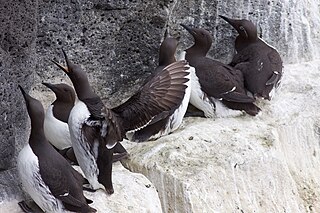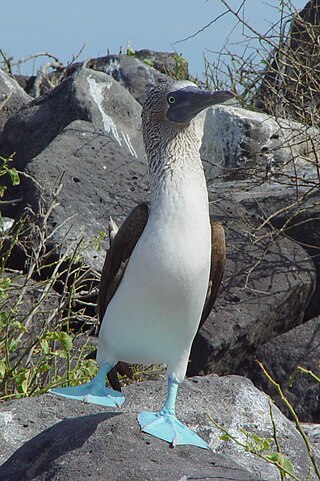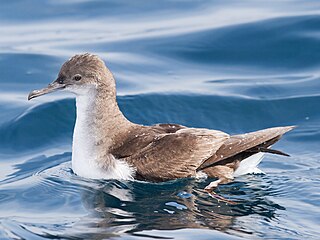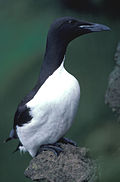
Puffins are any of three species of small alcids (auks) in the bird genus Fratercula. These are pelagic seabirds that feed primarily by diving in the water. They breed in large colonies on coastal cliffs or offshore islands, nesting in crevices among rocks or in burrows in the soil. Two species, the tufted puffin and horned puffin, are found in the North Pacific Ocean, while the Atlantic puffin is found in the North Atlantic Ocean.

An auk or alcid is a bird of the family Alcidae in the order Charadriiformes. The alcid family includes the murres, guillemots, auklets, puffins, and murrelets. The family contains 25 extant or recently extinct species that are divided into 11 genera.

A phalarope is any of three living species of slender-necked shorebirds in the genus Phalaropus of the bird family Scolopacidae.

Guillemot is the common name for several species of seabird in the Alcidae or auk family. In Europe, the term covers two genera: Uria and Cepphus. In North America the Uria species are called murres and only the Cepphus species are called "guillemots". This word of French origin derives from a form of the name William, cf. French: Guillaume.

The skuas are a group of predatory seabirds with seven species forming the genus Stercorarius, the only genus in the family Stercorariidae. The three smaller skuas, the Arctic skua, the long-tailed skua, and the pomarine skua, are called jaegers in North American English.

A booby is a seabird in the genus Sula, part of the family Sulidae. Boobies are closely related to the gannets (Morus), which were formerly included in Sula.

The black guillemot or tystie is a medium-sized seabird of the Alcidae family, native throughout northern Atlantic coasts and eastern North American coasts. It is resident in much of its range, but large populations from the high arctic migrate southwards in winter. The bird can be seen in and around its breeding habitat of rocky shores, cliffs and islands in single or smalls groups of pairs. They feed mainly by diving towards the sea floor feeding on fish, crustaceans or other benthic invertebrates. They are listed on the IUCN red list as a species of least concern.

The razorbill, razor-billed auk, or lesser auk is a North Atlantic colonial seabird and the only extant member of the genus Alca of the family Alcidae, the auks. It is the closest living relative of the extinct great auk.

The common murre also called the common guillemot or foolish guillemot,(Uria aalge) is a large auk. It has a circumpolar distribution, occurring in low-Arctic and boreal waters in the North Atlantic and North Pacific. It spends most of its time at sea, only coming to land to breed on rocky cliff shores or islands.

The thick-billed murre or Brünnich's guillemot is a bird in the auk family (Alcidae). This bird is named after the Danish zoologist Morten Thrane Brünnich. The very deeply black North Pacific subspecies Uria lomvia arra is also called Pallas' murre after its describer. The genus name is from Ancient Greek ouria, a waterbird mentioned by Athenaeus. The species term lomvia is a Swedish word for an auk or diver. The English "guillemot" is from French guillemot probably derived from Guillaume, "William". "Murre" is of uncertain origins, but may imitate the call of the common guillemot.

Puffinus is a genus of seabirds in the order Procellariiformes that contains about 20 small to medium-sized shearwaters. Two other shearwater genera are named: Calonectris, which comprises three or four large shearwaters, and Ardenna with another seven species.

The long-billed murrelet is a small seabird from the North Pacific. The genus name Brachyramphus is from Ancient Greek brakhus, "short", and rhamphos, "bill". The species name perdix is Latin for "partridge" Pallas described this auk as Magnitudine Perdicis. "Murrelet" is a diminutive of "murre", a word of uncertain origins, but which may imitate the call of the common guillemot.

Cepphus is a genus of seabirds in the auk family also referred to as true guillemots or, in North America, simply as guillemots. The genus name Cepphus is from Ancient Greek κέπφος kepphos, a pale waterbird mentioned by Greek authors including Aristotle. The English word "guillemot" is from French guillemot probably derived from Guillaume, "William". "Murre" is of uncertain origins but may imitate the call of the common guillemot.

Anser is a waterfowl genus that includes the grey geese and the white geese. It belongs to the true goose and swan subfamily of Anserinae under the family of Anatidae. The genus has a Holarctic distribution, with at least one species breeding in any open, wet habitats in the subarctic and cool temperate regions of the Northern Hemisphere in summer. Some also breed farther south, reaching into warm temperate regions. They mostly migrate south in winter, typically to regions in the temperate zone between the January 0 °C (32 °F) and 5 °C (41 °F) isotherms.

Grus is a genus of large birds in the crane family.

Porphyrio is the swamphen or swamp hen bird genus in the rail family. It includes some smaller species of gallinules which are sometimes separated as genus Porphyrula or united with the gallinules proper in Gallinula. The Porphyrio gallinules are distributed in the warmer regions of the world. The group probably originated in Africa in the Middle Miocene, before spreading across the world in waves from the Late Miocene to Pleistocene.

Ciconia is a genus of birds in the stork family. Six of the seven living species occur in the Old World, but the maguari stork has a South American range. In addition, fossils suggest that Ciconia storks were somewhat more common in the tropical Americas in prehistoric times.

Brachyramphus is a small genus of seabirds from the North Pacific. Brachyramphus is from Ancient Greek brakhus, "short", and rhamphos, "bill". In English the species are named as "murrelets"; this is a diminutive of "murre", a word of uncertain origins, but which may imitate the call of the common guillemot.

Synthliboramphus is a small genus of seabirds in the auk family from the North Pacific. The genus name Synthliboramphus is from Ancient Greek sunthlibo, "to compress", and rhamphos, "bill". The English name "Murrelet" is a diminutive of "murre", a word of uncertain origins, but which may imitate the call of the common guillemot.
Timothy Robert Birkhead is a British ornithologist. He has been Professor of Behaviour and Evolution at the University of Sheffield since 1976.























